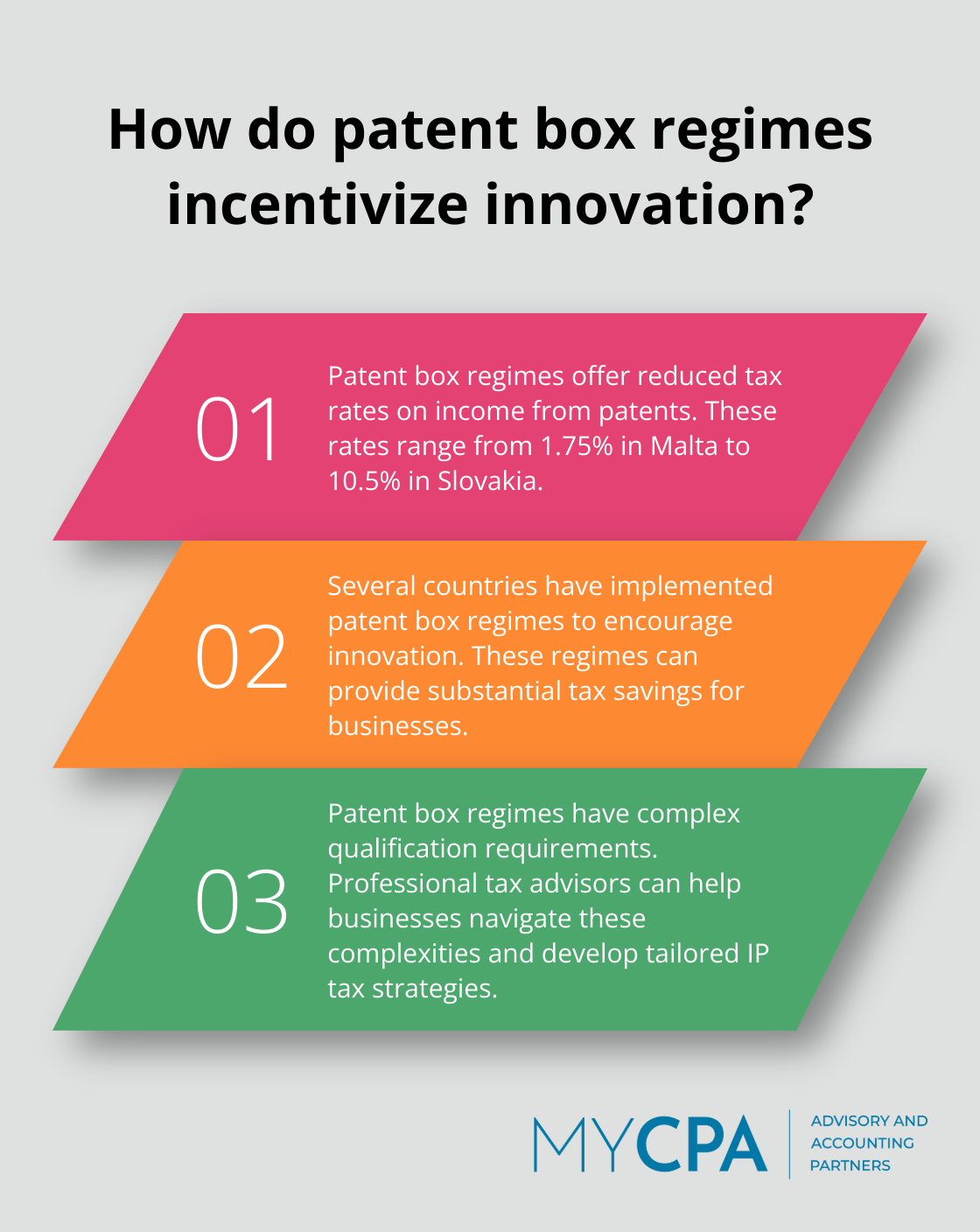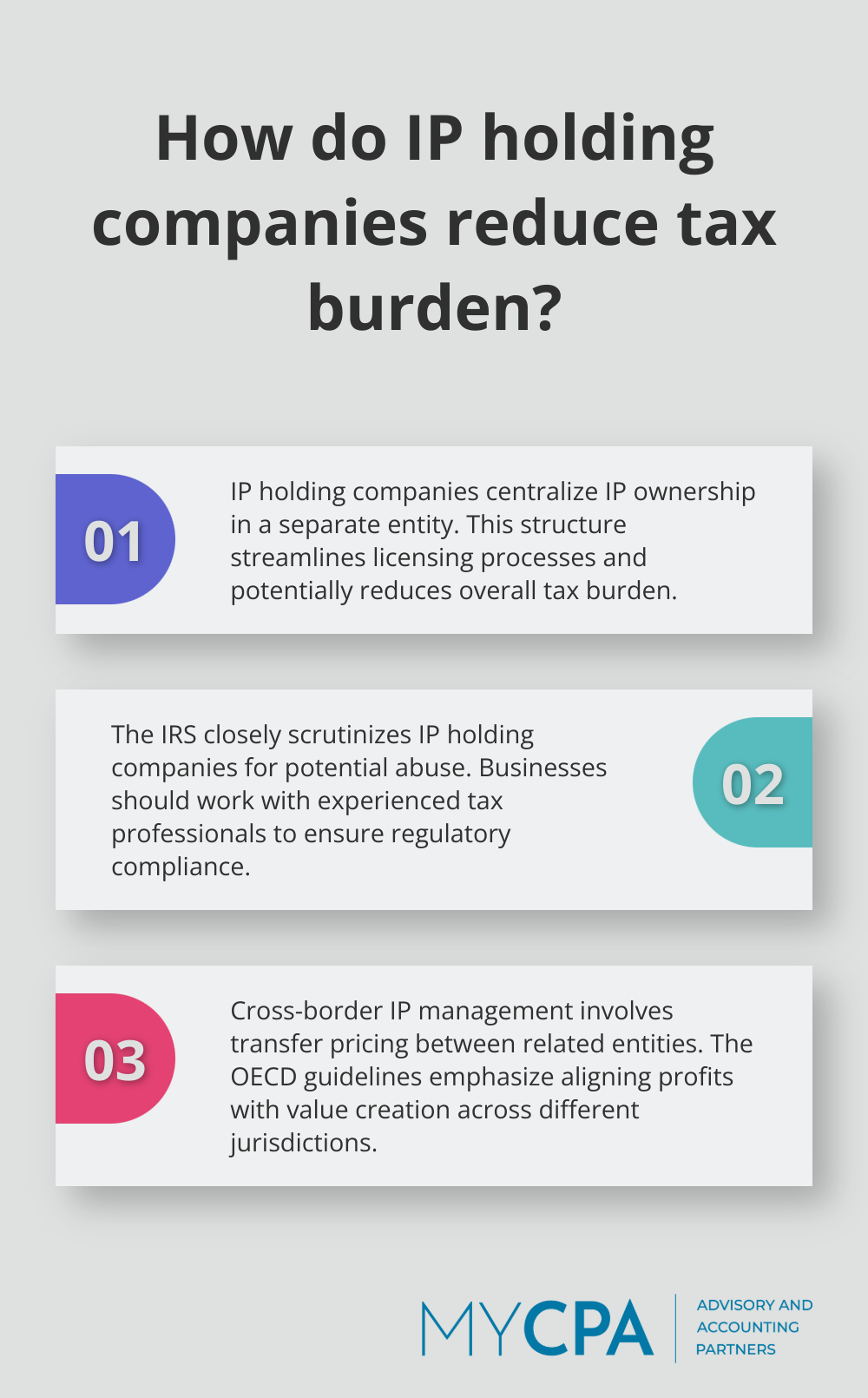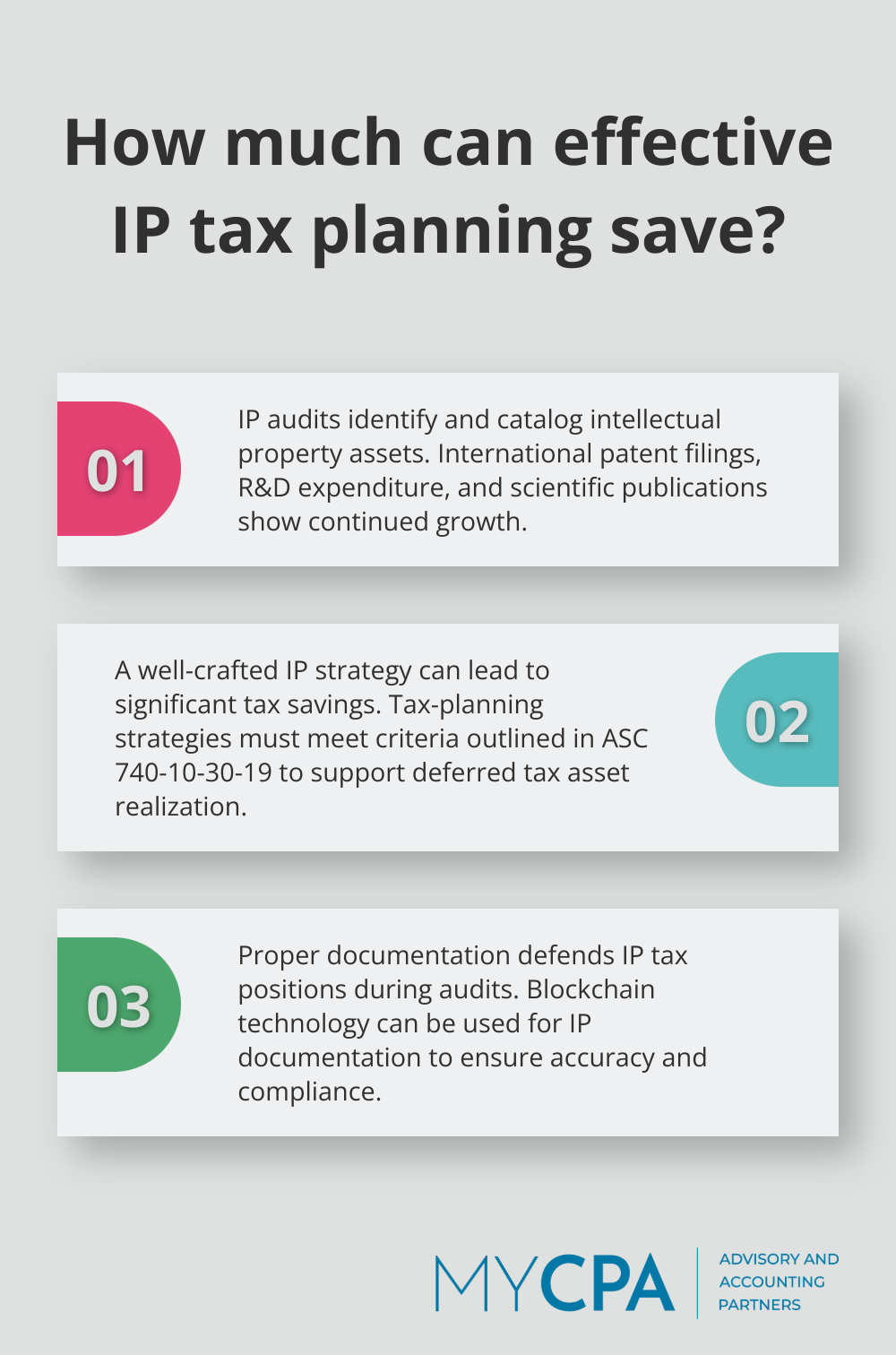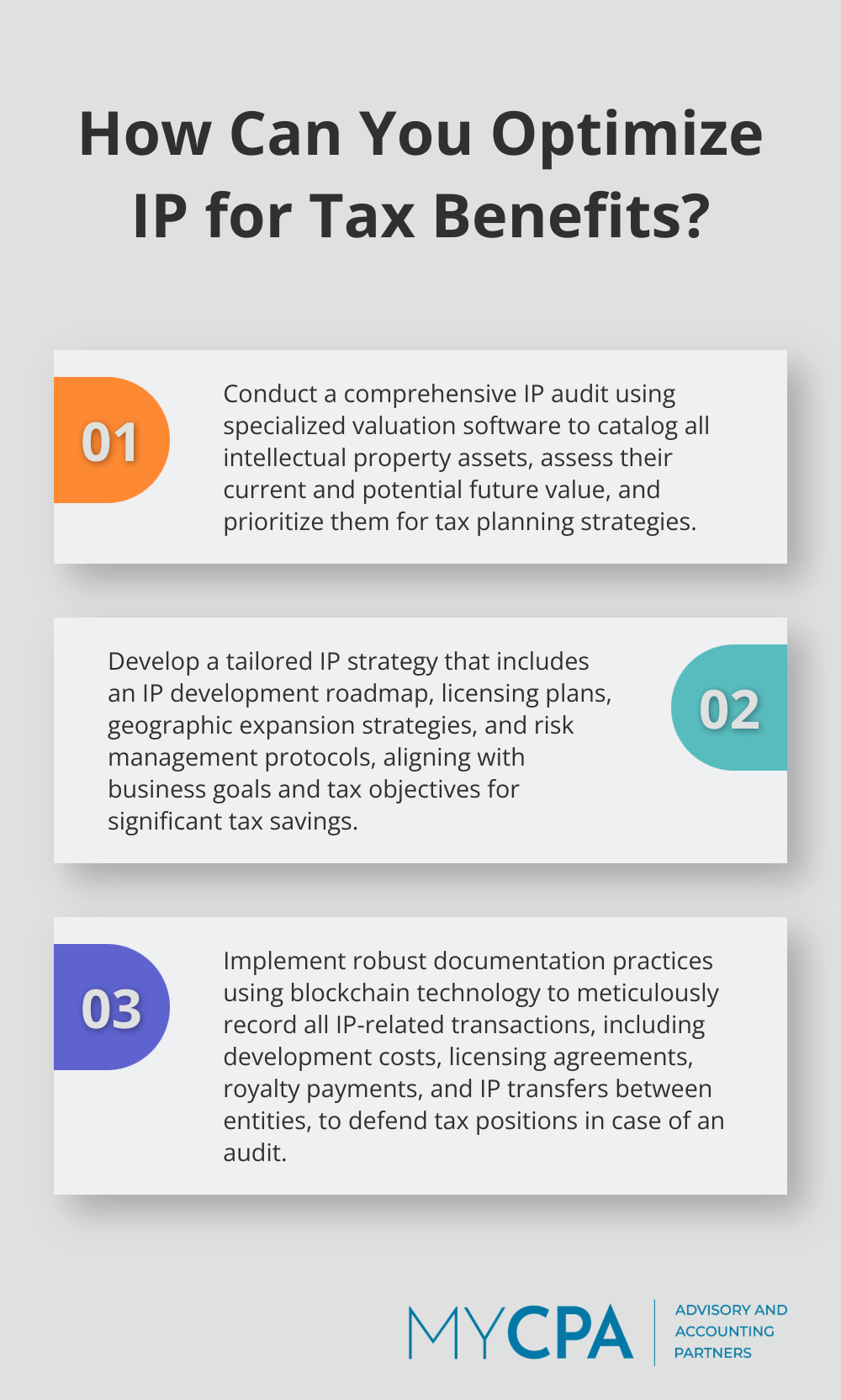
Intellectual property (IP) is a valuable asset for many businesses, but its tax implications can be complex and challenging. At My CPA Advisory and Accounting Partners, we understand the importance of effective IP tax planning to protect your intellectual assets and optimize your tax position.
In this post, we’ll explore key strategies for managing IP taxes, from understanding valuation methods to leveraging international tax incentives. We’ll also provide practical steps for implementing these strategies in your business, helping you maximize the value of your intellectual property while minimizing tax liabilities.
Intellectual property (IP) encompasses various assets, each with distinct tax implications. Patents, trademarks, copyrights, and trade secrets fall under the IP umbrella, but the tax code treats them differently. The Internal Revenue Service (IRS) typically allows patents to be amortized over 15 years for tax purposes. Trademarks, however, can be amortized indefinitely. Copyrights generate ordinary income when sold or licensed, impacting tax calculations differently from other IP types.
Determining the value of IP for tax purposes presents significant challenges. The IRS scrutinizes these valuations closely, as they substantially impact a company’s tax liability. One common valuation method is the income approach, which estimates future economic benefits of the IP. This method requires precise forecasting and often faces disputes due to its subjective nature.
International businesses face additional complexities in IP taxation. Transfer pricing rules apply when companies move IP between jurisdictions. The Organization for Economic Co-operation and Development’s (OECD) Base Erosion and Profit Shifting (BEPS) project has intensified focus on these practices. Companies must now maintain robust documentation of their IP transactions to comply with international tax regulations.
Many businesses overlook potential tax benefits associated with IP development. In the United States, the Research and Development (R&D) tax credit offers significant savings. A 2018 paper on the U.S. R&D credit found that projects benefiting from the credit had lower pretax profitability but more volatile returns. Claiming this credit requires meticulous record-keeping and a clear understanding of qualifying activities.
Several countries have implemented “patent box” regimes to incentivize innovation. These regimes offer reduced tax rates on income derived from patents. The reduced tax rates provided under patent box regimes range from 1.75 percent in Malta to 10.5 percent in Slovakia. While these regimes can offer substantial savings, they also come with complex qualification requirements.

The intricacies of IP tax implications underscore the importance of expert guidance. Professional tax advisors (such as those at MyCPA Advisory and Accounting Partners) can help businesses navigate these complexities and develop tailored IP tax strategies. As we move forward, we’ll explore effective IP tax planning strategies that can help protect and maximize the value of your intellectual assets.
IP holding companies offer a powerful way to manage and protect intellectual assets. Centralizing IP ownership in a separate entity allows businesses to streamline licensing processes and potentially reduce their overall tax burden.

The IRS closely scrutinizes IP holding companies for potential abuse. We recommend working with experienced tax professionals to ensure your structure aligns with current regulations and withstands potential audits.
For businesses operating internationally, cross-border IP management presents both opportunities and challenges. Transfer pricing – the practice of setting prices for transactions between related entities – is a critical aspect of this management.
The OECD’s recent guidelines on transfer pricing for intangibles emphasize the importance of aligning profits with value creation. Companies must carefully document how their IP contributes to value across different jurisdictions. Failure to do so can result in penalties.
Research and Development (R&D) tax credits remain an underutilized tool for many businesses developing IP. In the United States, these credits can provide a dollar-for-dollar reduction in tax liability.
To maximize these benefits, it’s essential to implement robust tracking systems for R&D activities. This includes documenting not just successful outcomes, but also failed experiments (as these can often qualify for the credit).
Patent box regimes, which offer reduced tax rates on income derived from patents, are gaining popularity globally. While the United States doesn’t currently have a federal patent box regime, several states have implemented similar programs. For example, New Jersey’s Technology Business Tax Certificate Transfer Program allows eligible technology and biotechnology businesses to sell their unused R&D tax credits and net operating losses for cash.
For businesses with international operations, countries like the Netherlands and the UK offer attractive patent box regimes. The UK’s regime allows for a reduced corporation tax rate on profits derived from patented inventions.
These strategies require careful planning and expert guidance. Professional tax advisors (such as those at MyCPA Advisory and Accounting Partners) can help businesses navigate the complex landscape of IP tax planning. The next section will explore practical steps to implement these strategies effectively in your business.
Start with a thorough IP audit. This process identifies and catalogs all your intellectual property assets. International patent filings, R&D expenditure, scientific publications, and other key innovation metrics have shown continued growth.

Assess the current value of each IP asset and its potential for future growth. This assessment is essential for making informed decisions about which assets to prioritize in your tax planning strategy. Consider specialized IP valuation software to streamline this process and ensure accuracy.
After your audit, create a comprehensive IP strategy that aligns with your business goals and tax objectives. This strategy should outline how you plan to develop, protect, and monetize your IP assets in a tax-efficient manner.
Include elements such as:
A well-crafted IP strategy can lead to significant tax savings. Tax-planning strategies must meet several criteria to be used to support realization of deferred tax assets, as described in ASC 740-10-30-19.
Effective IP tax planning requires a multidisciplinary approach. Engage tax professionals who specialize in IP matters and experienced IP lawyers to ensure your strategy is both legally sound and tax-efficient.
Select advisors with a track record of success in your industry. The right team can help you navigate complex issues like transfer pricing, cross-border transactions, and changing tax regulations.
Proper documentation defends your IP tax positions in case of an audit. Implement a system to meticulously record all IP-related transactions, including:
Try blockchain technology for IP documentation. Regular reviews of your documentation practices ensure you capture all necessary information and stay compliant with evolving regulations. This proactive approach can save significant time and resources in the long run.
Effective IP tax planning forms a critical component of modern business strategy. Companies can optimize their tax positions and protect intellectual assets through strategic IP management. This approach requires a comprehensive understanding of the IP portfolio, ongoing value assessment, and alignment with overall business objectives.

The landscape of IP taxation presents complex challenges that demand expertise and vigilance. We at MyCPA Advisory and Accounting Partners specialize in navigating these complexities. Our team can develop and implement tailored IP tax planning strategies that align with your business goals.
MyCPA offers services designed to optimize your IP tax position (from thorough IP audits to comprehensive tax strategies). Our cross-disciplinary approach ensures you benefit from expertise in both tax law and intellectual property management. Don’t leave your IP tax management to chance – partner with us to turn your intellectual property into a powerful tool for tax efficiency and business growth.








Privacy Policy | Terms & Conditions | Powered by Cajabra